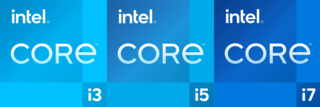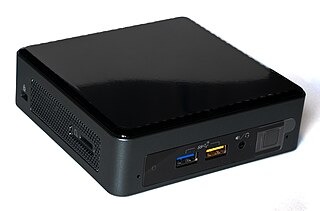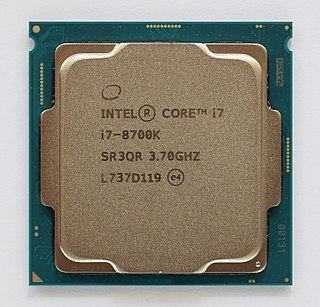Architecture changes compared to Coffee Lake
- AVX-512 instruction set extension
- Intel's first 10 nm process technology
| General information | |
|---|---|
| Launched | May 2018 (availability) |
| Discontinued | February 28, 2020 |
| Performance | |
| Max. CPU clock rate | 3.2GHz |
| Cache | |
| L1 cache | 64 KiB per core |
| L2 cache | 256 KiB per core |
| L3 cache | 4 MiB, shared |
| Architecture and classification | |
| Min. feature size | 10 nm (Tri-Gate) transistors |
| Architecture | x86-64 |
| Instructions | x86-64, Intel 64 |
| Extensions | |
| Physical specifications | |
| Cores |
|
| GPU(s) | Factory disabled |
| History | |
| Predecessor | Desktop: Coffee Lake (2nd optimization) Kaby Lake Refresh (2nd Optimization) |
| Successor | Ice Lake (Architecture) |
Cannon Lake (formerly Skymont) is Intel's codename for the 10-nanometer die shrink of the Kaby Lake microarchitecture. As a die shrink, Cannon Lake is a new process in Intel's "Process-Architecture-Optimization" execution plan as the next step in semiconductor fabrication. [2] Cannon Lake CPUs are the first mainstream CPUs to include the AVX-512 instruction set.
Prior to Cannon Lake's launch, Intel launched another 14 nm process refinement with the codename Coffee Lake. [3]
The successor of Cannon Lake microarchitecture is Ice Lake, which represents the architecture phase in the Intel Process-Architecture-Optimization Model. [4] [5]
Cannon Lake was initially expected to be released in 2015 [6] /2016, but the release was pushed back to 2018. [7] Intel demonstrated a laptop with an unknown Cannon Lake CPU at CES 2017 [8] [9] and announced that Cannon Lake based products would be available in 2018 at the earliest.
At CES 2018 Intel announced that it had started shipping mobile Cannon Lake CPUs at the end of 2017 and would ramp up production in 2018. [10] [11] [12]
On April 26, 2018 in its report on first-quarter 2018 financial results Intel stated it was currently shipping low-volume 10 nm product and expects 10 nm volume production to shift to 2019. [13] In July 2018, Intel announced that volume production of Cannon Lake would be delayed yet again, to late Q2 2019. [14]
The first laptop featuring a Cannon Lake CPU, namely Intel Core i3-8121U, a dual core CPU with Hyper-Threading and Turbo Boost but without an integrated GPU, was released in May 2018 in very limited quantities. [15] [16]
On August 16, 2018 Intel announced two new models of NUCs would use the 10 nm Cannon Lake-U i3-8121U CPU. [17] These models later became more readily available at retail in late November 2018.
On October 28, 2019, Intel announced that it will be discontinuing the i3-8121U and the Cannon Lake-powered Crimson Canyon NUC, with orders being taken till December 27, and shipping till February 28, 2020, [18] [19] making Cannon Lake not only one of the shortest-lived microarchitectures of Intel, but also the shortest-lived 10 nm x86 CPU microarchitecture (with only one CPU model to be released and manufactured for 1.5 years).
| Processor branding | Model | Cores (threads) | CPU | CPU Turbo clock rate | GPU | L3 cache | TDP | cTDP | Price (USD) |
|---|---|---|---|---|---|---|---|---|---|
| Down | |||||||||
| Core i3 | 8121U | 2 (4) | 2.2 GHz | 3.2 GHz | N/A | 4 MB | 15 W | N/A | ? |

Sandy Bridge is the codename for the microarchitecture used in the "second generation" of the Intel Core processors. The Sandy Bridge microarchitecture is the successor to Nehalem microarchitecture. Intel demonstrated a Sandy Bridge processor in 2009, and released first products based on the architecture in January 2011 under the Core brand.
Tick–tock was a production model adopted in 2007 by chip manufacturer Intel. Under this model, every microarchitecture change (tock) was followed by a die shrink of the process technology (tick). It was replaced by the process–architecture–optimization model, which was announced in 2016 and is like a tick–tock cycle followed by an optimization phase. As a general engineering model, tick-tock is a model that refreshes one side of a binary system each release cycle.
Advanced Vector Extensions are extensions to the x86 instruction set architecture for microprocessors from Intel and AMD proposed by Intel in March 2008 and first supported by Intel with the Sandy Bridge processor shipping in Q1 2011 and later on by AMD with the Bulldozer processor shipping in Q3 2011. AVX provides new features, new instructions and a new coding scheme.

Intel Core are streamlined midrange consumer, workstation and enthusiast computers central processing units (CPU) marketed by Intel Corporation. These processors displaced the existing mid- to high-end Pentium processors at the time of their introduction, moving the Pentium to the entry level, and bumping the Celeron series of processors to the low end. Identical or more capable versions of Core processors are also sold as Xeon processors for the server and workstation markets.

Intel Graphics Technology (GT) is the collective name for a series of integrated graphics processors (IGPs) produced by Intel that are manufactured on the same package or die as the central processing unit (CPU). It was first introduced in 2010 as Intel HD Graphics.

Skylake is the codename used by Intel for a processor microarchitecture that was launched in August 2015 succeeding the Broadwell microarchitecture. Skylake is a microarchitecture redesign using the same 14 nm manufacturing process technology as its predecessor, serving as a "tock" in Intel's "tick–tock" manufacturing and design model. According to Intel, the redesign brings greater CPU and GPU performance and reduced power consumption. Skylake CPUs share their microarchitecture with Kaby Lake, Coffee Lake, Cannon Lake, Whiskey Lake, and Comet Lake CPUs.

Broadwell is the fifth generation of the Intel Core Processor. It's Intel's codename for the 14 nanometer die shrink of its Haswell microarchitecture. It is a "tick" in Intel's tick–tock principle as the next step in semiconductor fabrication. Like some of the previous tick-tock iterations, Broadwell did not completely replace the full range of CPUs from the previous microarchitecture (Haswell), as there were no low-end desktop CPUs based on Broadwell.

Next Unit of Computing (NUC) is a line of small-form-factor barebone computer kits designed by Intel. It was previewed in 2012 and launched in early 2013. The NUC has developed over ten generations, spanning from Sandy Bridge-based Celeron CPUs in the first generation through Ivy Bridge-based Core i3 and i5 CPUs in the second generation to Gemini Lake-based Pentium and Celeron CPUs and Kaby Lake-based Core i3, i5, and i7 CPUs in the seventh and eighth generations. The NUC motherboard usually measures approximately 4 × 4 inches (10.16 × 10.16 cm), although some models have had different dimensions.

Zen is the codename for the first iteration in a family of computer processor microarchitectures of the same name from AMD. It was first used with their Ryzen series of CPUs in February 2017. The first Zen-based preview system was demonstrated at E3 2016, and first substantially detailed at an event hosted a block away from the Intel Developer Forum 2016. The first Zen-based CPUs codenamed "Summit Ridge" reached the market in early March 2017, Zen-derived Epyc server processors launched in June 2017 and Zen-based APUs arrived in November 2017.
Kaby Lake is Intel's codename for its seventh generation Core microprocessor family announced on August 30, 2016. Like the preceding Skylake, Kaby Lake is produced using a 14 nanometer manufacturing process technology. Breaking with Intel's previous "tick–tock" manufacturing and design model, Kaby Lake represents the optimized step of the newer process–architecture–optimization model. Kaby Lake began shipping to manufacturers and OEMs in the second quarter of 2016, and mobile chips have started shipping while Kaby Lake (desktop) chips were officially launched in January 2017.
The Xeon D is a brand of x86 system on a chip designed, manufactured, and marketed by Intel, targeted at the microserver market. It was announced in 2014, with the first products released in 2015. Related to the Xeon brand of workstation and server processors are based on the same architecture as server-grade CPUs, with support for ECC memory, higher core counts, support for larger amounts of RAM, larger cache memory. Unique to the Xeon D line, emphasis was also made on low power consumption, and integrated hardware blocks such as a network interface controllers, a PCI express root complex, and USB and SATA controllers.
Ice Lake is Intel's codename for the 10th generation Intel Core mobile processors based on the new Sunny Cove Core microarchitecture. Ice Lake represents an Architecture step in Intel's Process-Architecture-Optimization model. Ice Lake CPUs are sold together with the 14 nm Comet Lake CPUs as Intel's "10th Generation Core" product family.
Tiger Lake is Intel's codename for the 11th generation Intel Core mobile processors based on the new Willow Cove Core microarchitecture, manufactured using Intel's third-generation 10 nm process node known as 10SF. Tiger Lake replaces the Ice Lake family of mobile processors, representing an Optimization step in Intel's process–architecture–optimization model.

Coffee Lake is Intel's codename for its eighth generation Core microprocessor family, announced on September 25, 2017. It is manufactured using Intel's second 14 nm process node refinement. Desktop Coffee Lake processors introduced i5 and i7 CPUs featuring six cores and Core i3 CPUs with four cores and no hyperthreading.
Process–architecture–optimization is a development model for central processing units (CPUs) that Intel adopted in 2016. Under this three-phase (three-year) model, every microprocessor die shrink is followed by a microarchitecture change and then by one or more optimizations. It replaced the two-phase (two-year) tick–tock model that Intel adopted in 2006. The tick–tock model was no longer economically sustainable, according to Intel, because production of ever smaller dies becomes ever more costly.
Whiskey Lake is Intel's codename for a family of third 14 nm generation Skylake low-power mobile processors. Intel announced Whiskey Lake on August 28, 2018.
Rocket Lake is a codename for Intel’s desktop x86 chip family which is to be released in the first quarter of 2021. It will be based on the new Cypress Cove microarchitecture, a variant of Sunny Cove backported to the older 14nm process. The chips will be marketed as "Intel 11th generation Core". The Rocket Lake cores contain significantly more transistors than current Skylake-derived Comet Lake cores.
Alder Lake is Intel's codename for the 12th and upcoming generation of Intel Core processors based on a hybrid architecture utilizing Golden Cove high-performance cores and Gracemont power-saving cores. Intel expects to launch Alder Lake in the second half of 2021. It is expected to use the 10 nm Enhanced SuperFin (ESF) process and a new LGA 1700 socket with DDR5 support.
Gracemont is an upcoming microarchitecture for low-power processors used in systems on a chip (SoCs) made by Intel, and is the successor to Tremont. Like its predecessor, it will also be implemented as low-power cores in a hybrid design of the upcoming Alder Lake processors.